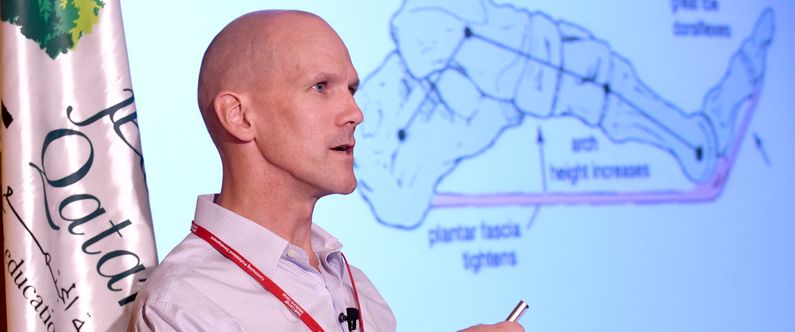WCM-Q Grand Rounds addresses plantar heel pain
 Craig Tanner of Aspetar spoke about plantar heel pain at WCM-Q Grand Rounds.
Craig Tanner of Aspetar spoke about plantar heel pain at WCM-Q Grand Rounds.
Craig Tanner, Senior Podiatrist in the Exercise and Sports Science Department at Aspetar, discussed planter heel pain in Qatar and the challenges involved in managing the condition.
His lecture identified risk factors for plantar heel pain relevant to the population in Qatar, outlined the potential risks to general health posed by the condition, and explained how to develop a simple management strategy for addressing plantar heel pain based on modifiable risk factors.
Speaking at Weill Cornell Medicine-Qatar’s (WCM-Q) Grand Rounds event, Tanner said: “Heel pain is interesting because it’s often seen in conjunction with other lower limb pain, it can have a pretty significant impact on life, it’s often found more in physically inactive people, and research has shown that people who suffer with it are socially more isolated. So, there’s a real impact beyond just having sore feet. Furthermore, it might be a significant impediment to exercise and we all know that perhaps the biggest public health problem we have got in the 21st century is physical inactivity.”
Heel pain also affects physically active people, whether they are recreational or professional athletes. Tanner said the risk factors for plantar heel pain include increased activity, increased standing activities – particularly on hard surfaces, poor footwear, obesity, pronated foot posture, cavus foot structure (abnormally high arches), and decreased ankle flexion. Because Qatar has relatively high rates of obesity and because many people here wear unsupportive sandals and flip flops to keep their feet cool, plantar heel pain is quite common, explained Tanner. The ultimate cause of the pain is strain of the long ligament that runs under the length of the foot.
Management of the condition should not involve prolonged rest, he said. Rather, exercise should continue but care should be taken to ensure properly supportive footwear is worn and foot-stretching exercises should be followed as directed by a qualified podiatrist. If the condition does not improve, the use night splints or specially made orthotics (inserts) may be advised, followed by injections and immobilization in a cast, with surgery the last option. In summation, Tanner said that wearing supportive footwear was of paramount importance in the prevention and management of heel pain and he showed a short video explaining how to choose good quality shoes.
The lecture, titled ‘Plantar Heel Pain in Qatar - Management & Challenges from a Podiatry Perspective’, was accredited locally by the Qatar Council for Healthcare Practitioners-Accreditation Department (QCHP-AD) and internationally by the Accreditation Council for Continuing Medical Education (ACCME).